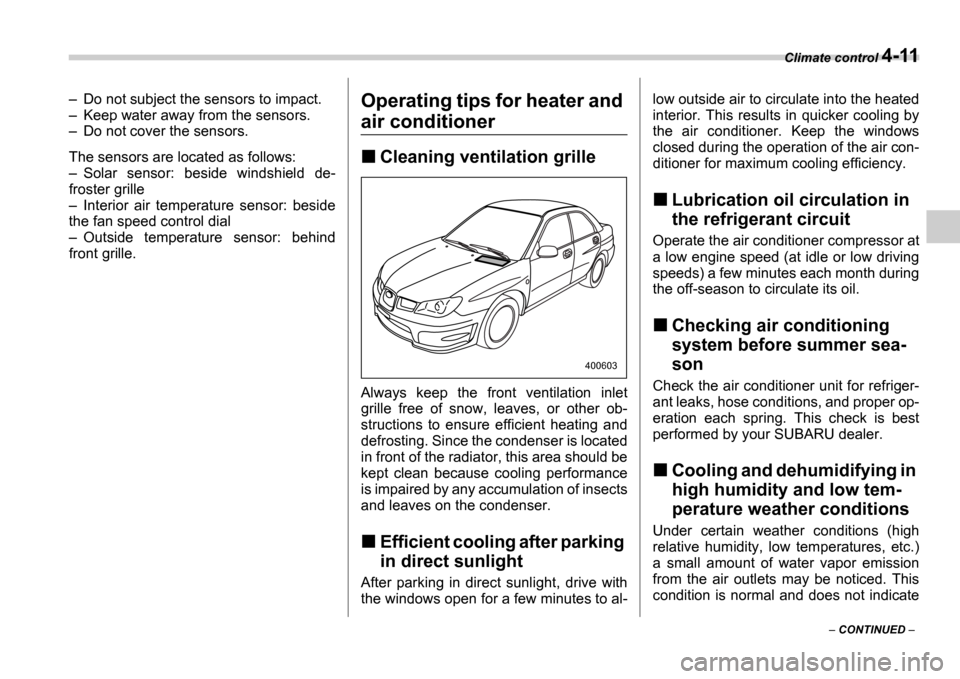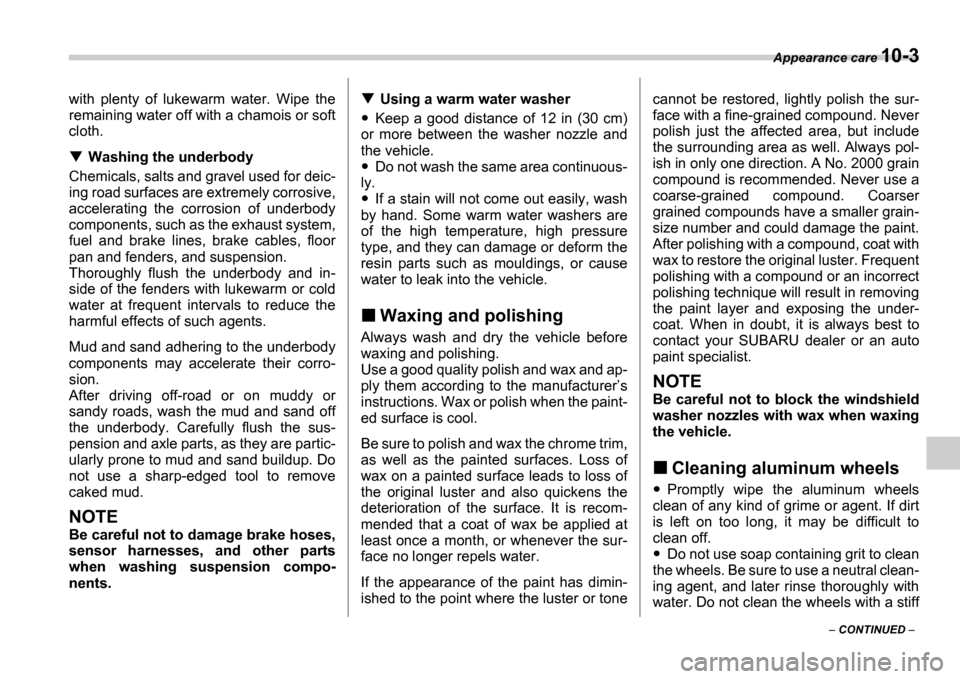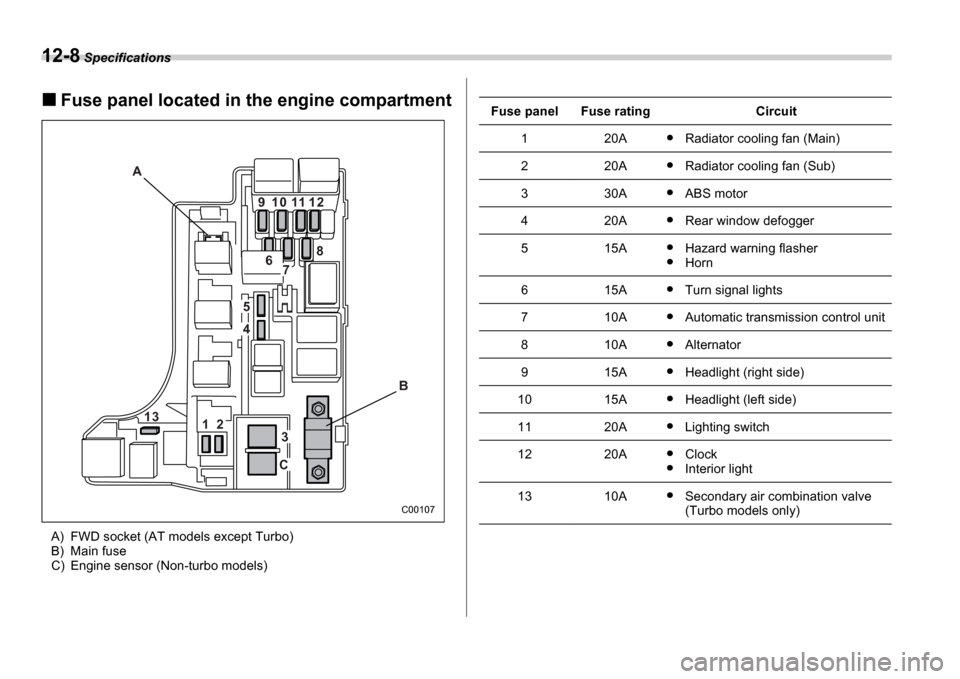2006 SUBARU IMPREZA WRX sensor
[x] Cancel search: sensorPage 160 of 365

Climate control 4-11
CONTINUED
Do not subject the sensors to impact.
Keep water away from the sensors.
Do not cover the sensors.
The sensors are located as follows: Solar sensor: beside windshield de-
froster grille Interior air temperature sensor: beside
the fan speed control dial Outside temperature sensor: behind
front grille.
Operating tips for heater and
air conditioner
Cleaning ventilation grille
Always keep the front ventilation inlet
grille free of snow, leaves, or other ob-
structions to ensure efficient heating and
defrosting. Since the condenser is located
in front of the radiator, this area should be
kept clean because cooling performance
is impaired by any accumulation of insects
and leaves on the condenser.
Efficient cooling after parking
in direct sunlight
After parking in direct sunlight, drive with
the windows open for a few minutes to al- low outside air to circulate into the heated
interior. This results in quicker cooling by
the air conditioner. Keep the windows
closed during the operation of the air con-
ditioner for maximum cooling efficiency.
Lubrication oil circulation in
the refrigerant circuit
Operate the air conditioner compressor at
a low engine speed (at idle or low driving
speeds) a few minutes each month during
the off-season to circulate its oil.
Checking air conditioning
system before summer sea-
son
Check the air conditioner unit for refriger-
ant leaks, hose conditions, and proper op-
eration each spring. This check is best
performed by your SUBARU dealer.
Cooling and dehumidifying in
high humidity and low tem-
perature weather conditions
Under certain weather conditions (high
relative humidity, low temperatures, etc.)
a small amount of water vapor emission
from the air outlets may be noticed. This
condition is normal and does not indicate
400603
Page 210 of 365

Starting and operating 7-13
CONTINUED
The drivers control center differential al-
lows you to freely change the degree of
limitation of the differential action (limited
slip differential (LSD) torque) of your vehi-
cle s center differential.
By using the center differential control di-
al, you can set an initial LSD torque to
match the road surface conditions, driving
conditions and your driving style.
1) LSD torque
2) Traction torque
A) Initial LSD torque (adjustable)
B) Mechanical LSD torque
NOTE
If you rapidly depress and release the
accelerator pedal while driving at low
speed, you may hear a knocking sound
from the vicinity of the center differen-
tial and rear differential. This sound oc-
curs because of the structure of the
center differential. It does not indicate
a problem.
Auto mode
In the auto mode, the system estimates
the driving and road conditions using sig-
nals from the wheel speed sensor, throttle
position sensor, steering angle sensor
and brake switch, etc. According to the re-
sult, it electronically and automatically
controls the degree of limitation of the dif-
ferential action (LSD torque) to optimize
the differential action of the center differ-
ential. When the ignition switch is turned
ON, the AUTO indicator light in the com-
bination meter comes on. The system can
be switched to a manual mode.
Manual mode
In the manual mode, you can use the cen-
ter differential control dial to adjust the ini-
In the event of failure of the driver
s
control center differential, the
indicator light will flash. Have the
vehicle inspected by your SUBARU
dealer.
700378
LOCK1
2A
B
700123
Page 276 of 365

Appearance care 10-3
CONTINUED
with plenty of lukewarm water. Wipe the
remaining water off with a chamois or soft
cloth.
Washing the underbody
Chemicals, salts and gravel used for deic-
ing road surfaces are extremely corrosive,
accelerating the corrosion of underbody
components, such as the exhaust system,
fuel and brake lines, brake cables, floor
pan and fenders, and suspension.
Thoroughly flush the underbody and in-
side of the fenders with lukewarm or cold
water at frequent intervals to reduce the
harmful effects of such agents.
Mud and sand adhering to the underbody
components may accelerate their corro-
sion.
After driving off-road or on muddy or
sandy roads, wash the mud and sand off
the underbody. Carefully flush the sus-
pension and axle parts, as they are partic-
ularly prone to mud and sand buildup. Do
not use a sharp-edged tool to remove
caked mud.
NOTE
Be careful not to damage brake hoses,
sensor harnesses, and other parts
when washing suspension compo-
nents.
Using a warm water washer
Keep a good distance of 12 in (30 cm)
or more between the washer nozzle and
the vehicle.
Do not wash the same area continuous-
ly.
If a stain will not come out easily, wash
by hand. Some warm water washers are
of the high temperature, high pressure
type, and they can damage or deform the
resin parts such as mouldings, or cause
water to leak into the vehicle.
Waxing and polishing
Always wash and dry the vehicle before
waxing and polishing.
Use a good quality polish and wax and ap-
ply them according to the manufacturer s
instructions. Wax or polish when the paint-
ed surface is cool.
Be sure to polish and wax the chrome trim,
as well as the painted surfaces. Loss of
wax on a painted surface leads to loss of
the original luster and also quickens the
deterioration of the surface. It is recom-
mended that a coat of wax be applied at
least once a month, or whenever the sur-
face no longer repels water.
If the appearance of the paint has dimin-
ished to the point where the luster or tone cannot be restored, lightly polish the sur-
face with a fine-grained compound. Never
polish just the affected area, but include
the surrounding area as well. Always pol-
ish in only one direction. A No. 2000 grain
compound is recommended. Never use a
coarse-grained compound. Coarser
grained compounds have a smaller grain-
size number and could damage the paint.
After polishing with a compound, coat with
wax to restore the original luster. Frequent
polishing with a compound or an incorrect
polishing technique will result in removing
the paint layer and exposing the under-
coat. When in doubt, it is always best to
contact your SUBARU dealer or an auto
paint specialist.
NOTE
Be careful not to block the windshield
washer nozzles with wax when waxing
the vehicle.
Cleaning aluminum wheels
Promptly wipe the aluminum wheels
clean of any kind of grime or agent. If dirt
is left on too long, it may be difficult to
clean off.
Do not use soap containing grit to clean
the wheels. Be sure to use a neutral clean-
ing agent, and later rinse thoroughly with
water. Do not clean the wheels with a stiff
Page 339 of 365

12-8 Specifications
Fuse panel located in the engine compartment
A) FWD socket (AT models except Turbo)
B) Main fuse
C) Engine sensor (Non-turbo models)
1 3
A
B
9
6
5
7
C
312
4 8
1 0 11 1 2
C00107
Fuse panelFuse ratingCircuit
120ARadiator cooling fan (Main)
220ARadiator cooling fan (Sub)
330AABS motor
420ARear window defogger
515AHazard warning flasher
Horn
615ATurn signal lights
710AAutomatic transmission control unit
810AAlternator
915AHeadlight (right side)
1015AHeadlight (left side)
1120ALighting switch
1220AClock
Interior light
1310ASecondary air combination valve
(Turbo models only)
Page 362 of 365

Index 14-7
Map light ......................................... ........................... 11-50
Parking light ...................................... ......................... 11-48
Rear combination lights ............................ ................. 11-48
Trunk light ........................................ .......................... 11-51
REV indicator light and buzzer ...................... ..................... 3-9
Rocking the vehicle ................................... ....................... 8-12
Roof rail and crossbar ............................... ....................... 8-14
S
Seat Fabric ............................................ ............................... 10-5
Heater ............................................ ................................ 1-5
Seatbelt .......................................... ....................................... 4
Extender ........................................... ........................... 1-19
Maintenance ........................................ ........................ 1-18
Pretensioners ....................................... ....................... 1-20
Safety tips ......................................... ............................. 1-9
Warning light and chime ............................ ......... 1-11, 3-14
Seatbelts .......................................... .................................. 1-9
Selector lever ...................................... ............................. 7-16
Position indicator .................................. ....................... 3-20
Shift lock release ................................... ........................... 7-19
Shock sensors .......................................... ........................ 2-17
Side ventilators ................................... ................................ 4-3
Snow tires ......................................... ................................ 8-10
Sounding a panic alarm ............................. ......................... 2-8
Spark plugs ......................................... ........................... 11-17
Specifications ....................................... ............................ 12-2
Speedometer ....................................... ...................... 3-6, 3-11
SRS airbag (Supplemental Restraint System
airbag) ........................................... ............................ 4, 1-35
SRS airbag system monitors ............................ ................ 1-56SRS airbag system servicing ............................
................ 1-57
SRS airbag system warning light ..................... ................. 3-15
SRS side airbag ................................... ............................. 1-51
Starting the engine ............................... ............................... 7-7
State emission testing (U.S. only) ................. ...................... 7-5
Stopping the engine ............................... ............................. 7-8
Storage compartments ................................ ....................... 6-4
Sun shades .......................................... ............................. 2-25
Sun visors ........................................... ................................ 6-3
Supplemental Restraint System airbag (SRS) ........... ....... 1-35
Synthetic leather upholstery .......................... ................... 10-5
T
Tachometer ......................................... ....................... 3-7, 3-12
Temperature gauge ................................. .................. 3-8, 3-13
Temporary spare tire ................................ .......................... 9-2
Tilt steering wheel ................................ ............................. 3-35
Tire
Chains ............................................. ............................. 8-11
Inspection ......................................... .......................... 11-30
Pressures and wear ................................... ................ 11-30
Replacement ........................................ ...................... 11-33
Rotation .......................................... ............................ 11-33
Tires .............................................. .................................... 12-4
Types ............................................... .......................... 11-30
Tires and wheels .................................... ......................... 11-30
Top tether anchorages ............................... ....................... 1-33
Towing ............................................ .................................. 9-11
All wheels on the ground ........................... ................... 9-14
Flat-bed truck ..................................... .......................... 9-13
Trailer Hitch .............................................. ............................... 8-17